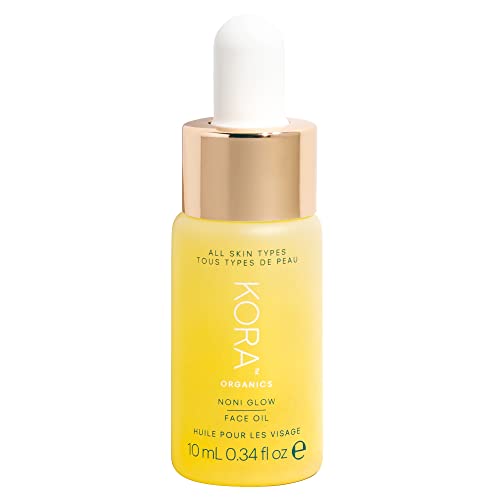
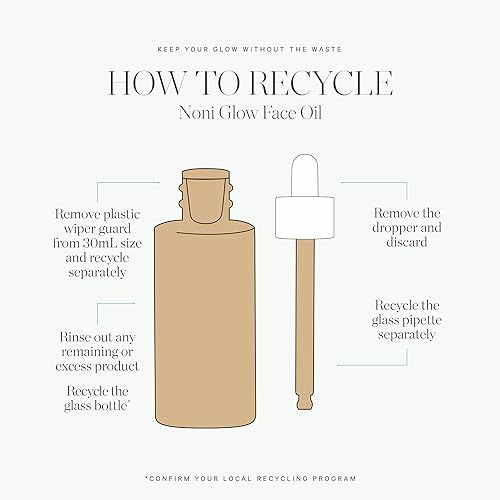
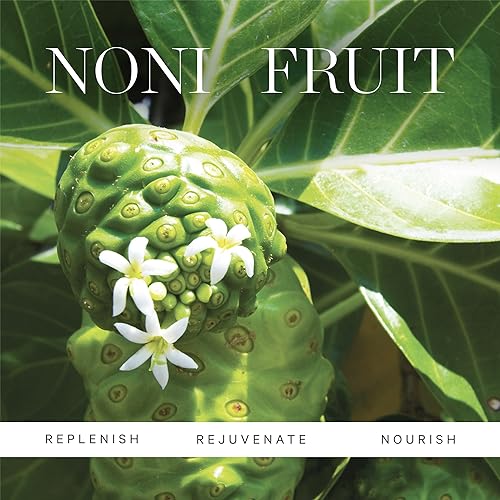
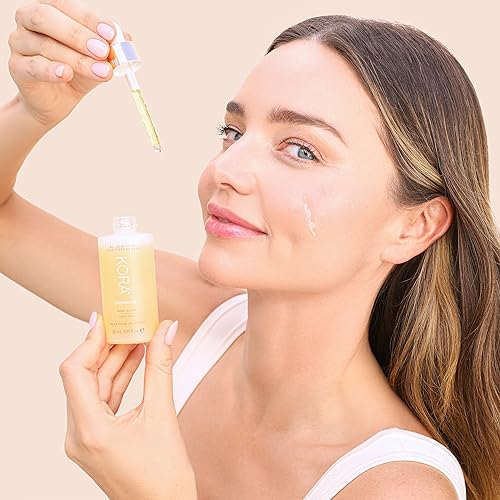
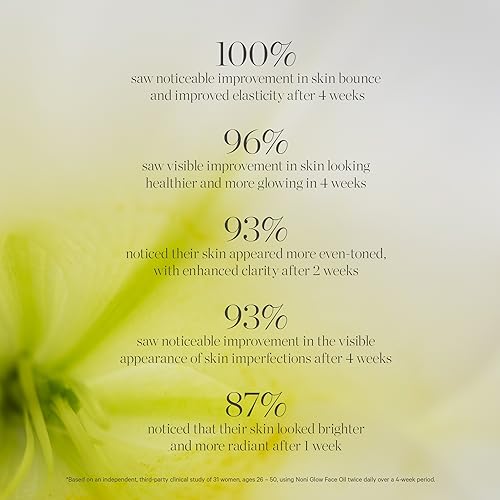
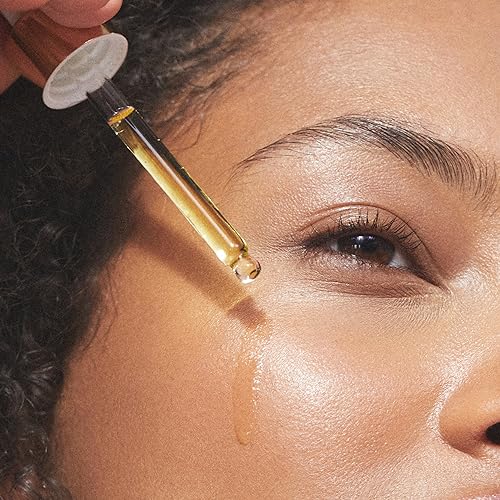
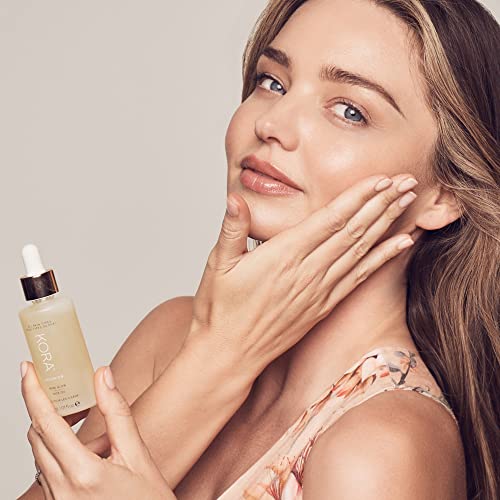
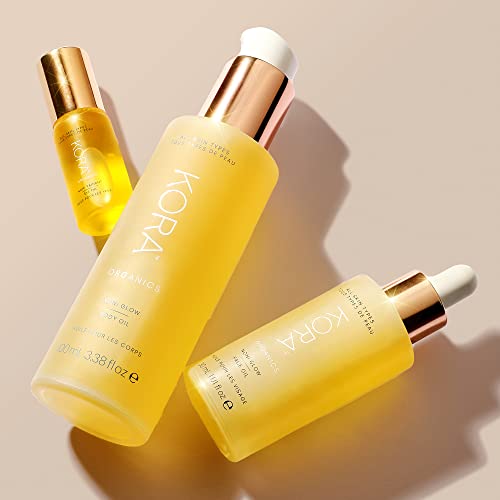
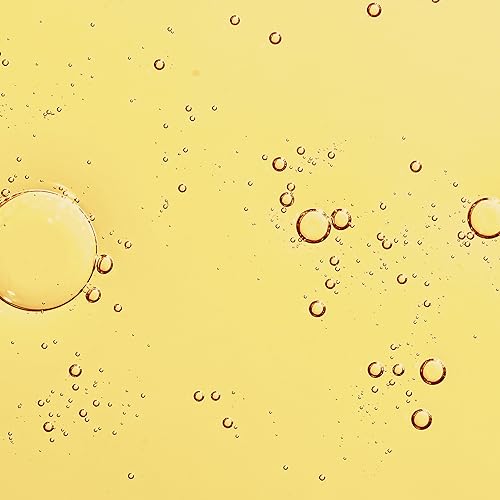
KORA Organics Noni Glow Face Oil - Nourish & Illuminate, Certified Organic - 0.34 fl oz


Rosa Damascena Extract
High RiskRosa damascena extract is an extract of the rose species, primarily used in cosmetics for its fragrance and potential skin benefits. It is often incorporated into formulations for its soothing properties and is associated with aromatherapy applications.
Sustai Insights
Rosa damascena extract offers functional benefits such as fragrance enhancement and potential skin soothing effects, appealing to consumers seeking natural ingredients. However, it is associated with a high allergenic potential, and while it has low concerns regarding carcinogenicity and reproductive toxicity, it faces regulatory restrictions in verified products. Environmental risks include possible pollutants, and due to its high allergenic concerns, the overall risk assessment is high, warranting cautious use and consideration of alternatives.
Eugenia Caryophyllus (Clove) Flower Extract
High RiskEugenia caryophyllus (clove) flower extract is derived from the flower buds of the clove tree, primarily used for its aromatic properties and as a natural preservative in various products. It contains bioactive compounds that may contribute to its functional benefits.
Sustai Insights
Eugenia caryophyllus (clove) flower extract offers functional benefits such as antimicrobial properties and is known for its use in aromatherapy. However, it has a high allergenic potential and may cause irritation in sensitive individuals. While it is not associated with significant carcinogenic or reproductive toxicity risks, regulatory bodies have placed some restrictions on its use. Overall, the ingredient presents a high risk level due to its potential health impacts. Safe usage practices should be observed, and alternatives like essential oils with lower allergenic potential may be considered.
Geraniol
High RiskGeraniol is a naturally occurring scent ingredient commonly found in essential oils from plants such as geraniums and lemongrass. It is primarily used for its pleasant floral aroma in perfumes, cosmetics, and household products.
Sustai Insights
Geraniol serves as a fragrance component and offers a natural option for scenting products. However, it has a high allergenic potential and may cause skin irritation in sensitive individuals. While it is considered low risk for carcinogenicity and reproductive toxicity, regulatory bodies have placed restrictions on its use due to allergenic concerns. Overall, the assessment reflects a high-risk level, particularly for those prone to allergies, highlighting the need for caution in its application.
Linalool
High RiskLinalool is a terpene commonly found in various plants, particularly in lavender and mint. It is primarily used in products for its fragrance and potential antimicrobial properties. Linalool is also utilized in formulations for its ability to enhance the sensory experience of personal care and household products.
Sustai Insights
Linalool offers functional benefits as a naturally occurring fragrance component and may exhibit antimicrobial properties. However, it presents high allergenic potential, with concerns about skin irritation and sensitization. Environmental risks include contamination issues, though it is not classified as a persistent pollutant. Regulatory bodies have noted the need for careful handling due to its allergenic nature. Overall, despite some beneficial attributes, the ingredient carries a high risk profile, warranting cautious use and consideration of safer alternatives.
Pelargonium Graveolens (Geranium) Flower Oil
High RiskPelargonium graveolens (geranium) flower oil is a volatile essential oil extracted from the leaves and stems of the Pelargonium graveolens plant. It is commonly used in cosmetics for its fragrance and potential skin benefits. This oil is characterized by its floral scent and is often included in formulations for aromatherapy, skincare, and personal care products.
Sustai Insights
Pelargonium graveolens flower oil offers functional benefits such as fragrance enhancement in cosmetic formulations. However, it has a high allergenic potential, posing risks of skin irritation and sensitization. Environmental concerns include its potential as a pollutant, though it is not bioaccumulative. Regulatory bodies do not currently restrict its use, but safety assessments are essential due to its allergenic properties. Overall, the ingredient carries a high risk level, necessitating cautious use, especially for sensitive populations. Alternatives such as synthetic fragrance compounds may mitigate allergenic risks.
Citronellol
High RiskCitronellol is a naturally occurring scent ingredient commonly found in various essential oils. It is primarily used for its aromatic properties in perfumes, cosmetics, and household products, contributing to fragrance profiles.
Sustai Insights
Citronellol serves as a fragrance component, enhancing product appeal. However, it has a high allergenic potential, posing risks of skin irritation and sensitization. Environmental concerns include contamination risks. Regulatory bodies have restrictions on its use, emphasizing caution. Overall, citronellol presents a high risk regarding health and safety, warranting careful consideration in product formulations.
Simmondsia Chinensis (Jojoba)
Low RiskSimmondsia chinensis, commonly known as jojoba, is an oil derived from the seeds of the jojoba plant. It is commonly used in cosmetic formulations for its moisturizing properties, acting as an emollient and skin conditioning agent.
Sustai Insights
Jojoba oil offers functional benefits such as effective skin moisturization and is biodegradable, with sustainable sourcing practices. Health risks are low, with minimal concerns regarding carcinogenicity, allergies, and reproductive toxicity. Environmental impact is negligible, with no pollutant or bioaccumulation potential. Regulatory status is favorable with no significant restrictions noted. Overall, it is assessed as low risk, and safe usage practices should be maintained. Alternatives include other plant-derived oils like argan or almond oil, which may provide similar benefits.
Lavandula Angustifolia (Lavender) Flower/Leaf/Stem Extract
Low RiskLavandula angustifolia, commonly known as lavender, is a flowering plant whose extracts are often used in personal care products for their aromatic properties. It is primarily employed for its fragrance, which is valued in cosmetics and skincare formulations.
Sustai Insights
Lavender offers functional benefits as a natural fragrance and is noted for its calming effects. It is generally considered safe with low reported health risks, including low potential for cancer, allergies, or reproductive toxicity. Environmentally, lavender is not associated with significant hazards and is not bioaccumulative. Regulatory bodies do not impose restrictions on its use. Overall, the risk level is assessed as low, making it a suitable ingredient in various applications. For those seeking alternatives, options such as chamomile or other botanicals may provide similar benefits.
Punica Granatum (Pomegranate) Seed Oil
Low RiskPunica granatum (pomegranate) seed oil is derived from the seeds of the pomegranate fruit. It serves primarily as a moisturizer and emollient in cosmetic formulations, contributing to skin hydration and texture improvement. The oil is rich in fatty acids and antioxidants, enhancing its functional properties in personal care products.
Sustai Insights
Punica granatum (pomegranate) seed oil offers functional benefits as a moisturizer and potential antioxidant. It is generally considered low risk for cancer, allergies, and reproductive toxicity, while contamination concerns are noted as low to moderate. Regulatory assessments do not impose significant restrictions on its use. Environmental impacts are minimal, and it is not classified as bioaccumulative. Safe usage practices are recommended, and alternatives may include other plant-based oils. Overall, the ingredient is assessed as low risk based on current scientific consensus.
Vitis Vinifera (Grape) Fruit Extract
Low RiskVitis vinifera (grape) fruit extract is an extract derived from the fruit of grapevine species. It is commonly used in cosmetic formulations for its antioxidant properties and potential skin benefits, such as hydration and soothing effects.
Sustai Insights
Vitis vinifera (grape) fruit extract offers functional benefits as an antioxidant, which may help protect skin from oxidative stress. It is sustainably sourced and generally considered safe, with low concerns for cancer, allergies, or reproductive toxicity. However, it poses minimal environmental risks and is not classified as a pollutant. Regulatory bodies have not imposed significant restrictions on its use. Overall, the ingredient is assessed to have a low risk profile, making it a suitable choice in cosmetic products.
Helianthus Annuus (Sunflower) Seed
Low RiskHelianthus annuus (sunflower) seed is derived from the seeds of the sunflower plant and is commonly used in various cosmetic and personal care products. It serves primarily as an emollient and skin conditioning agent, providing moisture and enhancing the texture of formulations.
Sustai Insights
Helianthus annuus (sunflower) seed offers functional benefits, including skin conditioning and moisturizing properties, while being sustainably sourced and biodegradable. Health risks are minimal, with low concerns for carcinogenicity, allergies, and reproductive toxicity. Environmentally, it presents low risks of pollution or bioaccumulation. Regulatory assessments indicate no current restrictions. Overall, it is considered a low-risk ingredient, and safe usage practices should be maintained. Alternative ingredients may include other plant-based oils, but the sunflower seed oil remains a viable option.
Isoamyl Cinnamate
Low RiskIsoamyl cinnamate is an organic compound commonly used as a fragrance ingredient in personal care and cosmetic products. It is valued for its sweet, fruity scent that resembles banana and is often utilized in formulations to enhance aroma and consumer appeal.
Sustai Insights
Isoamyl cinnamate demonstrates functional benefits as a fragrance component without significant health risks, categorized under low concerns for carcinogenicity, allergies, and reproductive toxicity. Environmental risks are minimal, as it is not classified as a pollutant or bioaccumulative. Regulatory assessments indicate no current restrictions, supporting its safe usage in cosmetics. Overall, it presents a low risk, making it a viable option in formulation, although alternatives should still be considered for sustainability.
Caprylic Triglyceride
Low RiskCaprylic triglyceride is an ester derived from coconut oil and glycerin, commonly used in cosmetic formulations as an emollient, stabilizer, and skin-conditioning agent. It helps to improve the texture and spreadability of products while providing a lightweight, non-greasy feel.
Sustai Insights
Caprylic triglyceride offers functional benefits such as enhanced skin moisturization and improved formulation stability. It is generally regarded as safe, with low concerns regarding carcinogenicity, allergenic potential, and reproductive toxicity. Environmental impact is minimal, with no significant pollutant or bioaccumulative properties identified. Regulatory bodies have not issued warnings or restrictions. Overall, the risk level is low, making it a suitable ingredient in cosmetic products. Safe usage practices include adhering to recommended concentrations, and while there are alternatives, caprylic triglyceride remains a reliable choice.
Tocopherol, D Alpha
Low RiskTocopherol, specifically d-alpha tocopherol, is a naturally occurring form of Vitamin E. It is commonly used in cosmetic and personal care products primarily for its antioxidant properties, helping to protect formulations from oxidation and extend shelf life.
Sustai Insights
D-alpha tocopherol provides effective antioxidant benefits, contributing to product stability. It is sustainably sourced and generally regarded as safe, with low concerns regarding carcinogenicity, allergies, and reproductive toxicity. However, there are minor concerns about endocrine disruption. Regulatory bodies have not imposed significant restrictions, indicating low overall risk. Recommended usage practices include adhering to established safe concentration thresholds. Alternatives, such as other forms of Vitamin E or plant-based antioxidants, may also be considered.
Simmondsia Chinensis (Jojoba)
Low RiskSimmondsia chinensis, commonly known as jojoba, is an oil derived from the seeds of the jojoba plant. It is commonly used in cosmetic formulations for its moisturizing properties, acting as an emollient and skin conditioning agent.
Sustai Insights
Jojoba oil offers functional benefits such as effective skin moisturization and is biodegradable, with sustainable sourcing practices. Health risks are low, with minimal concerns regarding carcinogenicity, allergies, and reproductive toxicity. Environmental impact is negligible, with no pollutant or bioaccumulation potential. Regulatory status is favorable with no significant restrictions noted. Overall, it is assessed as low risk, and safe usage practices should be maintained. Alternatives include other plant-derived oils like argan or almond oil, which may provide similar benefits.
Rosa Damascena Extract
High RiskRosa damascena extract is an extract of the rose species, primarily used in cosmetics for its fragrance and potential skin benefits. It is often incorporated into formulations for its soothing properties and is associated with aromatherapy applications.
Sustai Insights
Rosa damascena extract offers functional benefits such as fragrance enhancement and potential skin soothing effects, appealing to consumers seeking natural ingredients. However, it is associated with a high allergenic potential, and while it has low concerns regarding carcinogenicity and reproductive toxicity, it faces regulatory restrictions in verified products. Environmental risks include possible pollutants, and due to its high allergenic concerns, the overall risk assessment is high, warranting cautious use and consideration of alternatives.
Lavandula Angustifolia (Lavender) Flower/Leaf/Stem Extract
Low RiskLavandula angustifolia, commonly known as lavender, is a flowering plant whose extracts are often used in personal care products for their aromatic properties. It is primarily employed for its fragrance, which is valued in cosmetics and skincare formulations.
Sustai Insights
Lavender offers functional benefits as a natural fragrance and is noted for its calming effects. It is generally considered safe with low reported health risks, including low potential for cancer, allergies, or reproductive toxicity. Environmentally, lavender is not associated with significant hazards and is not bioaccumulative. Regulatory bodies do not impose restrictions on its use. Overall, the risk level is assessed as low, making it a suitable ingredient in various applications. For those seeking alternatives, options such as chamomile or other botanicals may provide similar benefits.
Punica Granatum (Pomegranate) Seed Oil
Low RiskPunica granatum (pomegranate) seed oil is derived from the seeds of the pomegranate fruit. It serves primarily as a moisturizer and emollient in cosmetic formulations, contributing to skin hydration and texture improvement. The oil is rich in fatty acids and antioxidants, enhancing its functional properties in personal care products.
Sustai Insights
Punica granatum (pomegranate) seed oil offers functional benefits as a moisturizer and potential antioxidant. It is generally considered low risk for cancer, allergies, and reproductive toxicity, while contamination concerns are noted as low to moderate. Regulatory assessments do not impose significant restrictions on its use. Environmental impacts are minimal, and it is not classified as bioaccumulative. Safe usage practices are recommended, and alternatives may include other plant-based oils. Overall, the ingredient is assessed as low risk based on current scientific consensus.
Vitis Vinifera (Grape) Fruit Extract
Low RiskVitis vinifera (grape) fruit extract is an extract derived from the fruit of grapevine species. It is commonly used in cosmetic formulations for its antioxidant properties and potential skin benefits, such as hydration and soothing effects.
Sustai Insights
Vitis vinifera (grape) fruit extract offers functional benefits as an antioxidant, which may help protect skin from oxidative stress. It is sustainably sourced and generally considered safe, with low concerns for cancer, allergies, or reproductive toxicity. However, it poses minimal environmental risks and is not classified as a pollutant. Regulatory bodies have not imposed significant restrictions on its use. Overall, the ingredient is assessed to have a low risk profile, making it a suitable choice in cosmetic products.
Eugenia Caryophyllus (Clove) Flower Extract
High RiskEugenia caryophyllus (clove) flower extract is derived from the flower buds of the clove tree, primarily used for its aromatic properties and as a natural preservative in various products. It contains bioactive compounds that may contribute to its functional benefits.
Sustai Insights
Eugenia caryophyllus (clove) flower extract offers functional benefits such as antimicrobial properties and is known for its use in aromatherapy. However, it has a high allergenic potential and may cause irritation in sensitive individuals. While it is not associated with significant carcinogenic or reproductive toxicity risks, regulatory bodies have placed some restrictions on its use. Overall, the ingredient presents a high risk level due to its potential health impacts. Safe usage practices should be observed, and alternatives like essential oils with lower allergenic potential may be considered.
Helianthus Annuus (Sunflower) Seed
Low RiskHelianthus annuus (sunflower) seed is derived from the seeds of the sunflower plant and is commonly used in various cosmetic and personal care products. It serves primarily as an emollient and skin conditioning agent, providing moisture and enhancing the texture of formulations.
Sustai Insights
Helianthus annuus (sunflower) seed offers functional benefits, including skin conditioning and moisturizing properties, while being sustainably sourced and biodegradable. Health risks are minimal, with low concerns for carcinogenicity, allergies, and reproductive toxicity. Environmentally, it presents low risks of pollution or bioaccumulation. Regulatory assessments indicate no current restrictions. Overall, it is considered a low-risk ingredient, and safe usage practices should be maintained. Alternative ingredients may include other plant-based oils, but the sunflower seed oil remains a viable option.
Geraniol
High RiskGeraniol is a naturally occurring scent ingredient commonly found in essential oils from plants such as geraniums and lemongrass. It is primarily used for its pleasant floral aroma in perfumes, cosmetics, and household products.
Sustai Insights
Geraniol serves as a fragrance component and offers a natural option for scenting products. However, it has a high allergenic potential and may cause skin irritation in sensitive individuals. While it is considered low risk for carcinogenicity and reproductive toxicity, regulatory bodies have placed restrictions on its use due to allergenic concerns. Overall, the assessment reflects a high-risk level, particularly for those prone to allergies, highlighting the need for caution in its application.
Linalool
High RiskLinalool is a terpene commonly found in various plants, particularly in lavender and mint. It is primarily used in products for its fragrance and potential antimicrobial properties. Linalool is also utilized in formulations for its ability to enhance the sensory experience of personal care and household products.
Sustai Insights
Linalool offers functional benefits as a naturally occurring fragrance component and may exhibit antimicrobial properties. However, it presents high allergenic potential, with concerns about skin irritation and sensitization. Environmental risks include contamination issues, though it is not classified as a persistent pollutant. Regulatory bodies have noted the need for careful handling due to its allergenic nature. Overall, despite some beneficial attributes, the ingredient carries a high risk profile, warranting cautious use and consideration of safer alternatives.
Pelargonium Graveolens (Geranium) Flower Oil
High RiskPelargonium graveolens (geranium) flower oil is a volatile essential oil extracted from the leaves and stems of the Pelargonium graveolens plant. It is commonly used in cosmetics for its fragrance and potential skin benefits. This oil is characterized by its floral scent and is often included in formulations for aromatherapy, skincare, and personal care products.
Sustai Insights
Pelargonium graveolens flower oil offers functional benefits such as fragrance enhancement in cosmetic formulations. However, it has a high allergenic potential, posing risks of skin irritation and sensitization. Environmental concerns include its potential as a pollutant, though it is not bioaccumulative. Regulatory bodies do not currently restrict its use, but safety assessments are essential due to its allergenic properties. Overall, the ingredient carries a high risk level, necessitating cautious use, especially for sensitive populations. Alternatives such as synthetic fragrance compounds may mitigate allergenic risks.
Isoamyl Cinnamate
Low RiskIsoamyl cinnamate is an organic compound commonly used as a fragrance ingredient in personal care and cosmetic products. It is valued for its sweet, fruity scent that resembles banana and is often utilized in formulations to enhance aroma and consumer appeal.
Sustai Insights
Isoamyl cinnamate demonstrates functional benefits as a fragrance component without significant health risks, categorized under low concerns for carcinogenicity, allergies, and reproductive toxicity. Environmental risks are minimal, as it is not classified as a pollutant or bioaccumulative. Regulatory assessments indicate no current restrictions, supporting its safe usage in cosmetics. Overall, it presents a low risk, making it a viable option in formulation, although alternatives should still be considered for sustainability.
Caprylic Triglyceride
Low RiskCaprylic triglyceride is an ester derived from coconut oil and glycerin, commonly used in cosmetic formulations as an emollient, stabilizer, and skin-conditioning agent. It helps to improve the texture and spreadability of products while providing a lightweight, non-greasy feel.
Sustai Insights
Caprylic triglyceride offers functional benefits such as enhanced skin moisturization and improved formulation stability. It is generally regarded as safe, with low concerns regarding carcinogenicity, allergenic potential, and reproductive toxicity. Environmental impact is minimal, with no significant pollutant or bioaccumulative properties identified. Regulatory bodies have not issued warnings or restrictions. Overall, the risk level is low, making it a suitable ingredient in cosmetic products. Safe usage practices include adhering to recommended concentrations, and while there are alternatives, caprylic triglyceride remains a reliable choice.
Citronellol
High RiskCitronellol is a naturally occurring scent ingredient commonly found in various essential oils. It is primarily used for its aromatic properties in perfumes, cosmetics, and household products, contributing to fragrance profiles.
Sustai Insights
Citronellol serves as a fragrance component, enhancing product appeal. However, it has a high allergenic potential, posing risks of skin irritation and sensitization. Environmental concerns include contamination risks. Regulatory bodies have restrictions on its use, emphasizing caution. Overall, citronellol presents a high risk regarding health and safety, warranting careful consideration in product formulations.
Tocopherol, D Alpha
Low RiskTocopherol, specifically d-alpha tocopherol, is a naturally occurring form of Vitamin E. It is commonly used in cosmetic and personal care products primarily for its antioxidant properties, helping to protect formulations from oxidation and extend shelf life.
Sustai Insights
D-alpha tocopherol provides effective antioxidant benefits, contributing to product stability. It is sustainably sourced and generally regarded as safe, with low concerns regarding carcinogenicity, allergies, and reproductive toxicity. However, there are minor concerns about endocrine disruption. Regulatory bodies have not imposed significant restrictions, indicating low overall risk. Recommended usage practices include adhering to established safe concentration thresholds. Alternatives, such as other forms of Vitamin E or plant-based antioxidants, may also be considered.
Discover the KORA Organics Noni Glow Hydrating Face Oil, a luxurious blend designed to nourish and illuminate your skin. This certified organic, cruelty-free facial oil is a perfect addition to any skincare routine, promoting a radiant, youthful complexion.
- Nourishing Hydration: Infused with organic Noni Extract and Rosehip Oil, this face oil deeply hydrates, enhancing skin elasticity and bounce for a smoother appearance.
- Rich in Antioxidants: The unique combination of Pomegranate Oil and Sea Buckthorn Oil provides essential fatty acids and powerful antioxidants, protecting your skin from environmental stressors.
- Easy Application: Simply warm a few drops in your hands and gently press onto your face and neck, making it an effortless step in your daily skincare ritual.
- Vegan & Cruelty-Free: KORA Organics is committed to ethical practices, creating products without artificial fragrances or colors, ensuring a clean beauty routine.
- Daily Use for Best Results: Incorporate this face oil into your morning and evening skincare regimen for optimal hydration and radiant results.
Subscribe & Save with Sustai
- Best Price Guarantee: Always enjoy the lowest prices on sustainable home essentials.
- No Surprises: We’ll notify you before shipping. No hidden fees, ever.
- You’re in Charge: Change, pause, or cancel your subscription anytime with ease.
- Eco-Friendly Deliveries: Our grouped shipments mean less packaging and lower emissions.
Join us on a sustainable journey. Special offers for a limited time! Prices and promotions may change.
Recommended Products
Discover the KORA Organics Noni Glow Hydrating Face Oil, a luxurious blend designed to nourish and illuminate your skin. This certified organic, cruelty-free facial oil is a perfect addition to any skincare routine, promoting a radiant, youthful complexion.
- Nourishing Hydration: Infused with organic Noni Extract and Rosehip Oil, this face oil deeply hydrates, enhancing skin elasticity and bounce for a smoother appearance.
- Rich in Antioxidants: The unique combination of Pomegranate Oil and Sea Buckthorn Oil provides essential fatty acids and powerful antioxidants, protecting your skin from environmental stressors.
- Easy Application: Simply warm a few drops in your hands and gently press onto your face and neck, making it an effortless step in your daily skincare ritual.
- Vegan & Cruelty-Free: KORA Organics is committed to ethical practices, creating products without artificial fragrances or colors, ensuring a clean beauty routine.
- Daily Use for Best Results: Incorporate this face oil into your morning and evening skincare regimen for optimal hydration and radiant results.

You can have at most 2 Sustainable Steals products in your cart
Customer Reviews
Customers’ View
Customers appreciate the moisturizing properties and gentle formulation of KORA Organics Noni Glow Hydrating Face Oil, which leaves skin feeling hydrated and radiant. Many users highlight its pleasant natural scent and the glow it imparts without greasiness, making it suitable for sensitive skin. One customer noted, "It gives you a nice silky smooth and glowy look without oily skin." While satisfaction with the quality is high, some customers express mixed feelings about its value for money, citing the small size for the price. Overall, the product aligns well with health-conscious and eco-friendly values, being cruelty-free and made from organic ingredients, reinforcing its appeal to environmentally aware consumers.
AI-generated from the text of customer reviewsThis product is rated 4.4 of 5.0 stars.
It has received 23 reviews.




